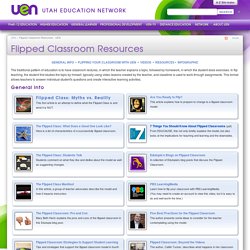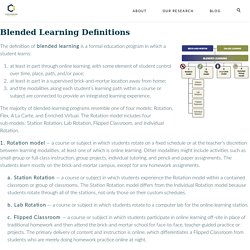

Flipped Classroom Resources. The traditional pattern of education is to have classroom lectures, in which the teacher explains a topic, followed by homework, in which the student does exercises.

In flip teaching, the student first studies the topic by himself, typically using video lessons created by the teacher, and classtime is used to work through assignments. This format allows teachers to answer individual student's questions and create interactive learning activities. General Info PBS LearningMediaLearn how to flip your classroom with PBS LearningMedia. (You may need to create an account to view this video, but it is easy to do and well worth the time.) Flipped Classroom: Beyond the VideosThe author, Caitlin Tucker, describes what happens in her classroom and suggests three things that could make the move to the model more appealing to teachers. Flipping Your Classroom with UEN UEN offers several resources to help you teach using the flipped classroom model. Videos Resources The Flipped Classroom Infographic.
Todd Nesloney. 15 education chats worth your time. Next Generation Science Standards. EX - Alabama Learning Exchange. Current Students content from old ESS site. Create 3D digital designs with online CAD. Cool Coding Apps and Websites for Kids. Online Testing Free Quiz Maker Create the Best web-based quizzes ClassMarker.
Interactive Quizzes and Surveys in minutes. Free Tools To create and Administer Quizzes. Assessment Maker. QuestBase is a web-based, cross-platform application that provides everything you need to create and manage your assessments, tests, quizzes and exams, both on-line and printed.

Designed as a training and learning tool, QuestBase can also be used for selection tests, psychological tests, satisfaction and opinion surveys, market researches and customer feedback. As easy as 1-2-3 No software to install or configure — just create and take assessments from any computer or device (for example, a tablet or a chromebook) with an internet connection, or print them on paper automatically, even in multiple different versions and with a professional, modern and great-looking layout. Start saving time with powerful features Who can use QuestBase? As an educational tool, QuestBase helps teachers create self-grading quizzes, assign them to students, assess their performance and analyze results. Blended Learning Model Definitions. The definition of blended learning is a formal education program in which a student learns: at least in part through online learning, with some element of student control over time, place, path, and/or pace;at least in part in a supervised brick-and-mortar location away from home;and the modalities along each student’s learning path within a course or subject are connected to provide an integrated learning experience.

The majority of blended-learning programs resemble one of four models: Rotation, Flex, A La Carte, and Enriched Virtual. The Rotation model includes four sub-models: Station Rotation, Lab Rotation, Flipped Classroom, and Individual Rotation. 1. Rotation model — a course or subject in which students rotate on a fixed schedule or at the teacher’s discretion between learning modalities, at least one of which is online learning. A. B. C. D. 2. 3. 6 Models of Blended Learning - DreamBox Learning. As school districts look for ways to give their students a personalized learning experience without expanding their budgets, blended learning can be an effective option.

This approach to schooling combines face-to-face instruction with online learning and has yielded strong results since officially being researched as an education strategy. In fact, according to a 2010 study from the U.S. Department of Education, blended learning classes produce statistically better results than their face-to-face, non-hybrid equivalents. This may be partly due to the fact that this rapidly growing model not only increases the flexibility and individualization of student learning experiences, but also allows teachers to expand the time they spend as facilitators of learning. Schools make the switch to blended learning for a variety of reasons. 1) Face-to-Face Driver Model Of all the blended learning models, face-to-face driver is the closest to a typical school structure. 2) Rotation Model. Www.tcea.org/documents/PD/TCEA App Evaluation Rubric.pdf. Blended-learning-report-202013.pdf.